
Australia So Much to See

A. Put simply, it means leaving nothing behind, so all you really need is the ability to take any waste, including general rubbish, toilet waste and any water used with you for appropriate disposal elsewhere. The expectation is that these caravans or motorhomes will have their own toilet and shower, and a tank to collect and confine waste water. However it is not about having the equipment to do so, but about doing it right and this can be achieved simply without the need for having a large fully self sufficient caravan or motorhome. Some will allow waste water disposal on the vegetation on site.
Often but not always these campsites have a dump point for disposal of toilet cassette and waste water tank contents nearby. Some may have a water source but many do not.
The CMCA (Campervan and Motorhome Club of Australia) have a Leave No Trace® Scheme which members and associate members may join and receive a compliance sticker. This is not required to camp at any sites other than CMCA members only self contained campgrounds. Displaying the LNT sticker may make inspection easier at some other self contained only campgrounds, eg Kalgoorlie-Boulder RV Stop Spot, Western Australia.
Members who participate in the Leave No Trace® Scheme must have a vehicle that meets the requirements for the specified holding capacity for fresh, grey and black water, as well as storage capacity for garbage waste. To qualify, a self-contained vehicle must retain ALL waste within the confines of the vehicle, and leave no trace whatsoever of its visit to a site. Vehicle owners must sign a declaration that they will comply with the Code of Conduct for the Leave No Trace® Scheme at all times. Vehicles that have qualified for the Scheme will display an accreditation card when overnighting. In addition, the vehicle owner carries proof of their participation in this Scheme and this documentation can be produced upon request.
In joining they are agreeing to meet the Leave No Trace® Scheme Code of Conduct and CMCA Self Contained Vehicle (SCV) Policy including:

How to meet the requirements
Toilet: If you do not have an inbuilt toilet, a portable toilet can be carried for use inside
your caravan, annex or in a toilet tent. With combinations available on eBay this need not be an expensive purchase. A twenty litre
cassette toilet would be a better choice than a toilet with a ten litre cassette if you have room to store the slightly taller toilet.
Tank storage size would not be so critical if there is a dump point on site to enable daily emptying. Most built in caravan toilets
have twenty litre cassettes and some motorhomes or buses may have larger built in tanks.
Grey Water collection: Many motorhomes and an increasing number of caravans have a fitted grey water or sullage tank. A very convenient option is a portable purpose built grey water tank such as this 40 litre tank on eBay where the same product is also listed by several others sellers, as well as on line stores. They can also be purchased in 25 litre capacity. Other brands and sources include Caravans Plus who sell similar Fiamma 40 litre tanks. Check they are accepted at your proposed campground #.
A ten or twenty litre canister set up as a grey water collection is an easy to make portable water tank for water removal from site in campgrounds where unsealed grey water collection tanks are permitted. Ensure there is no overflow or spillage. Photos contributed by members of the Caravanners Forum.
Homemade grey water tanks such as these can work well, but unless they are sealed with a pressure relief outlet they are subject to overflowing and may not be acceptable to some Self Contained Only campgrounds.
Rubbish: While some campsites will have bins or a skip on site, most do not. Carrying rubbish in a small bin or bag until a suitable bin or rubbish disposal point is found is not difficult. Canvas rubbish bags that fit onto the spare wheels on the back of four wheel drive vehicles are commercially available.
All campers will carry a rubbish bin or bag of some sort. If needed to carry rubbish for some time, food scraps can become smelly. It can be as simple as ‘double bagging’ the rubbish to avoid this, or having a rubbish bag or bin on the exterior of your rig.
Shower: Self containment descriptions often specify an on board shower. While how we keep clean does not need to be so detailed, this is more about not allowing outdoor showers where it is hard to prevent water from running onto the ground.
Water: A self contained traveller needs to carry adequate water if the campground does not have water provision for campers. Depending on the area, there may be a free caravan water fill point in the town; ask at the local Visitor Centre or Shire.
Electricity: Most campers now expect to be able to use at least electric lights in their camper, often electric water pumps, and sometimes small appliances, computers and television sets. For this reason the self contained traveller is expected to have on board batteries and preferably a means of charging them such as solar panels. Generators within specified hours are permitted in some campgrounds but many do not allow them.
Campfires: Many campgrounds do not allow fires, and an alternative source of fuel for cooking is preferable in any campground. If campfires are permitted and it is safe to light an open fire, they can be used, extinguished and any trace removed. Read about campfire safety and prohibited burning times.
· Do not decimate bush when collecting firewood. You may need to bring your own from an alternative source.
· Use of a fire ring can help contain coals.
· When fully extinguished (with water) and cold, coals can be removed for later disposal or if anywhere suitable nearby, scattered. A sprinkle of soil across the top will leave no trace of your fire.
In places where collection method is not critical, a responsible user can remove water from site in a ten or twenty litre water canister or second hand container, a large bucket with a sealable lid, or a collapsible twenty litre water canister. The latter can be carried taking up little space, and several can be on hand. Ensuring no spillage when left on the outlet may be an issue.
Site regulations may prohibit buckets being used for collection as although this works for many of us, it can result in spillage whilst transferring to a sealable container, or people may be careless and allow the bucket to overflow whilst showering. A purpose built grey water tank, be it built in or portable, is the specified option at a number of campgrounds. At Gwalia in Western Australia, the Leonora Council specifies it allows collection in 20 litre canisters for removal to and disposal at the dump point near the Leonora townsite.
Grey Water No grey water is to be discharged from a self-contained vehicle unless allowable by local authorities or access to a dump point is impractical. Sinks, and where fitted hand basins and showers, shall be drained to either an on-board (fitted) grey water tank or an external (non-fitted) grey water tank (tote).
Campsites signed for Self Contained Only do not allow grey water (waste water) to be disposed of on the ground. They may or may not have a dump point on site for your convenience.
A amall rubbish bin placed in a frame on the caravan a-frame, with the bin and lid held securely with occy straps (above left), is one way to remove rubbish when bush camping for extended periods with a caravan or trailer. For those with rear mounted spare tyres, there are a number of brands of canvas rubbish bags to hang on the tyre (above right).
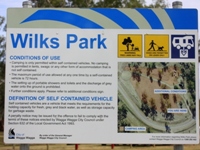
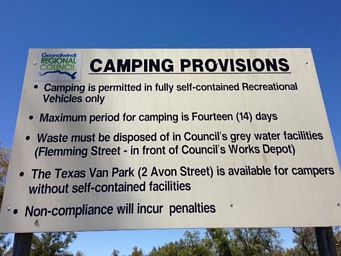
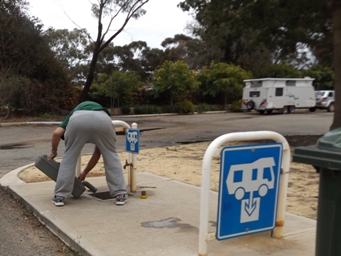
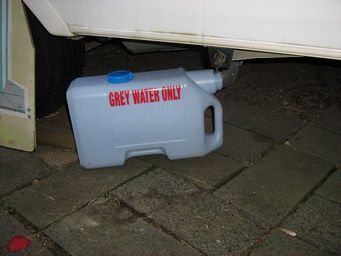
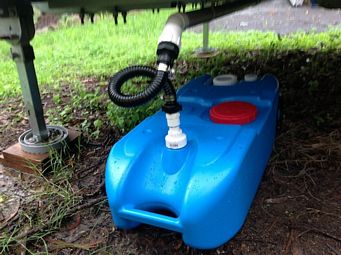
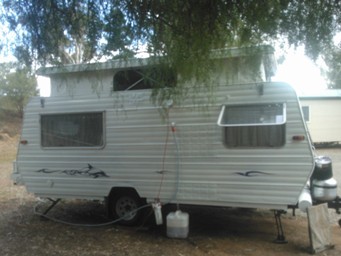
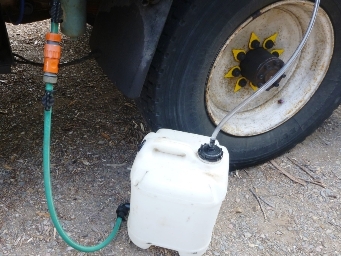
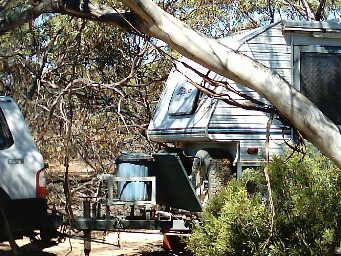
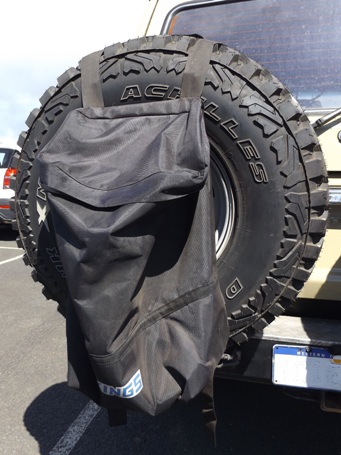
If you find the next bin along the road overflowing, do not deposit your rubbish beside it as this creates a mess, particularly if scavenger birds or animals tear the bags open. Wait until there is a better opportunity, or ask at the local Shire about access to their waste management site. While this sounds like what everyone would do, sights seen at roadside rest areas indicate that they are people who do not, and just dump their rubbish around the overflowing bin.